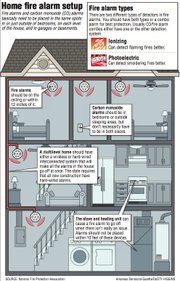Autumn has arrived. The temperatures have dipped, and leaves are changing color and falling.
It’s also an ideal time to change the batteries in smoke and carbon monoxide alarms, according to Battalion Chief Marty Hamrick of the Jonesboro Fire Department.
“We usually tell people to change the batteries when they change their clocks,” Hamrick says, referring to the end of daylight saving time Nov. 3.
Fall is a time when everyone’s carbon monoxide and fire alarms start sounding, Hamrick says.
“Our biggest problem is that people don’t maintain the batteries,” he says.
It’s also the time of year when residents switch from air conditioning, which is typically electric, to heating, often powered by gas, creating added fire and carbon monoxide dangers.
FIRE ALARMS
Every house should have multiple fire alarms, Hamrick says. In fact, that’s part of the Arkansas Fire Protection Code of 2007 and the state’s building code, which as part of the fire code is modeled after the International Residential Code for One and Two-Family Dwellings.
“Arkansas building code specifies you have to have hard-wired alarms with battery backups,” Hamrick says, citing part of the state code based on the international code.
At least, in theory, that is.
It’s up to each county or municipality to decide if they plan to follow that code, Hamrick adds. Municipal and county codes trump state codes, Hamrick says.
For multifamily dwellings, like apartment buildings, the Arkansas fire marshal and county or city fire marshals will be sure that happens. For single-family houses, it’s a mixed bag around the state.
Most cities, including Little Rock, Fayetteville, Bentonville and Jonesboro, adhere to the state fire codes, but applications can vary. Little Rock building inspectors, for example, follow new construction and remodeling projects from start to finish and will include fire alarms in their final inspection, according to Charles Givens, building codes manager for the city. In Jonesboro, it’s up to architects and builders to make sure houses are up to code, Hamrick says.
Remodeled houses may also need to have a new, hard-wired alarm system, according to the international code. In Little Rock, houses being remodeled to include a new bedroom must only upgrade the new portions of the structure with hard-wired alarms, according to Givens. The rest of the house falls under previous codes in which battery-operated alarms were OK, he says.
“There is no requirement for existing homes unless they are adding a new addition that has a bedroom and only the bedroom would have to have a smoke detector as well as one outside the bedroom,” Givens says. “Also, if they are rewiring an existing structure the whole structure would be required to add smoke detectors as a part of the rewire to meet the code.”
In Bentonville, too, an additional room will not mean the entire house needs to be retrofitted, according to the city’s chief building inspector, Lance Blasi. If a complete renovation of a house is planned, however, then hard-wired alarms must be installed.
Homeowners concerned about the fire safety of their house should consider the following.
Where are the fire alarms? “Smoke alarms are required [under National Fire Protection Association code] outside each sleeping area, on every level of the home and in each bedroom,” says Lee Richardson, senior electrical engineer with the association, a group that writes fire regulations adopted in most states, including Arkansas. “They’re required to be on the ceiling or not below 12 inches from the ceiling.” The same requirements can be found in codes adopted in Arkansas.
What type of alarms are they? “There are basically two detection technologies,” Richardson says. “One is ionization, and the other is photoelectric.” Ionizing alarms detect flaming fires better, while photoelectric detection is good for nonflaming or smoldering fires. Some manufacturers make combination ionizing-photoelectric alarms, but those are few and far between. “Of course, you don’t know what type of fire you’re going to have, so we recommend having both,” Richardson says. Most fire alarms list the type on the package. The type is also listed in product specifications at online stores such as lowes.com and homedepot.com. Combination alarms are also available from companies like First Alert and Kidde.
Are the alarms interconnected? The Arkansas building codes recommend hard-wired, interconnected alarms with battery backup, according to Hamrick. These types of detection systems are particularly ideal for multilevel dwellings and larger houses and are required in those types of dwellings by NFPA codes. “Let’s say you’re in a big house, and your smoke alarm in the basement goes off while you’re up on the second or third floor,” Richardson says. “You might hear it, but if you’re sleeping it’s not going to be loud enough for you to hear.” Interconnected alarms, however, will all activate if there’s an alarm in any area of the house. Typically installing an interconnected alarm system means hiring an electrician. The systems, which include the SC9120B combination photoelectric/ ionization alarms from First Alert and the Firex i5000 from Kidde, are available at stores such as Lowe’s and Home Depot for do-it-yourselfers with electrical know how.
How old are the alarms? Most new fire alarms have a life expectancy of about 10 years. That’s why the NFPA and the U.S. Fire Administration recommend buying new alarms every 10 years or less. Be sure to check the manufacturer’s instructions, however, to make sure an alarm will last that long.
Are they near cooking appliances? Smoke alarms should not be installed within 10 feet of a cooking appliance, Richardson says. That’s because alarms within range of such appliances tend to give off false alarms more frequently. “They go off,” he says. “Then, people mute them, and they’re without protection.” In a small apartment or studio, alarms can be within six feet of a stove, however. Richardson recommends buying an alarm with a mute button, so that it can be silenced without completely deactivating the alarm. Also, try a photoelectric alarm near stoves since that technology is less sensitive to cooking fumes than ionizing alarms are.
Are the alarms listed? All smoke alarms - and carbon monoxide alarms, for that matter - should be “listed,” Richardson says. “By that I mean they need to bear the label of a recognized listing organization,” he says. Listing organizations test alarms to make sure they work as they’re supposed to. The largest of these is Underwriters Laboratory, which frequently works with the NFPA.
What if they need to be replaced? Replacing a single, battery-powered alarm is a breeze, but replacing an alarm in a system can be more difficult. Look for alarms from the same manufacturer or those listed as compatible with the current system, Richardson says. Also, look for wireless alarms that can be added on to existing systems if an extra alarm is needed in a bedroom or basement, he says.
What if a system is financially out of reach? “A basic smoke alarm that costs $10 at Lowe’s or a basic carbon monoxide alarm that costs the same will do the job,” Hamrick says. “They just won’t have any special features.” And they won’t be tied together. In smaller houses, that won’t matter as much, Richardson says.
CARBON MONOXIDE ALARMS
Carbon monoxide alarms are similar to fire alarms in that they need to be installed on every level of a house and in or just outside of every sleeping area. Unlike fire alarms, carbon monoxide detectors do not need to be placed on the ceiling or high on the wall since carbon monoxide is roughly the same density as air.
Instead, Richardson says carbon monoxide detection units should be wherever the manufacturer recommends. Plug-in alarms will be placed low due to the location of most electrical outlets, of course, but unless the alarm is near a heating unit or another appliance that gives off carbon monoxide, it should work at any height, he says. (Alarms that are in the room with a heating unit or near a fireplace or vent should be placed high on the wall or on the ceiling, he adds.)
Who needs a carbon monoxide alarm? Typically, anyone with natural gas or propane appliances or wood-burning stoves or fireplaces should have a carbon monoxide alarm, according to Hamrick. These fixtures can give off the deadly, odorless gas if they malfunction.
What type of carbon monoxide alarm is best? Carbon monoxide alarms, like fire alarms, range from very basic to ones with digital readout and others that can be synced or hard-wired together. The most important thing, as with fire alarms, is that the carbon monoxide detector be listed or certified by an approving agency, Richardson says.
When should they be replaced? “CO alarms are required to be replaced when they reach their end of life,” Richardson says. Many of the newer models send out an end-of-life signal to alert users when the alarm needs to be replaced. Carbon monoxide alarms typically last up to seven years, he says, but those numbers are improving. Kidde recently launched a Worry-Free line of carbon monoxide alarms that last up to 10years thanks to a new lithium battery. It all depends on the manufacturer and what type of sensor the alarm uses.
Also, Hamrick says, be sure to test both types of alarms once a month.
HomeStyle, Pages 39 on 11/23/2013


